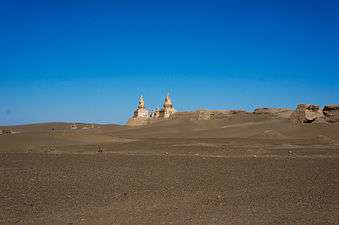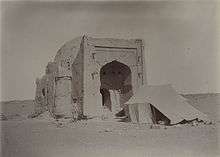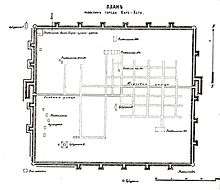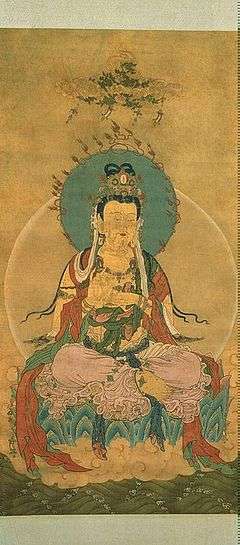Khara-Khoto
Khara-Khoto (Mongolian: Khar Khot "black city")[1] was a Tangut city in the Ejin Banner of Alxa League in western Inner Mongolia near Juyan Lake Basin. It has been identified as the city of Etzina, which appears in The Travels of Marco Polo. The present banner Ejin Banner is named after this city.

Name
Khara-Khoto is known by many names, including Chinese: 黑城 Hēichéng "black city", Tangut: 𗋽𗰞 /*zjɨ̱r²-nja̱¹/ "black water"[2] (transcribed into Chinese as 亦集乃 Yijinai), Modern Mongolian Khar khot (Middle Mongol language:ᠬᠠᠷᠠ
ᠬᠣᠲᠠ Khara Khoto, "black city") and to Chinese as Heishui City (Chinese: 黑水城 Hēishuǐchéng, "black water city").
History
The city was founded in 1032 and became a thriving center of Western Xia trade in the 11th century. There are remains of 30-foot (9.1 m)-high ramparts and 12-foot (3.7 m)-thick outer walls.[3] The outer walls ran for some 421 m (1,381 ft) east-west by 374 m (1,227 ft) north-south.[4]
The walled fortress was first taken by Genghis Khan in 1226,[5] but—contrary to a widely circulated misunderstanding—the city continued to flourish under Mongol overlordship. During Kublai Khan's time, the city was expanded, reaching a size three times bigger than during the Tangut Empire. Toghon Temür concentrated his preparation for the reconquest of China at Khara-Khoto. The city was located on the crossroads connecting Karakorum, Shangdu and Kumul.
In The Travels of Marco Polo, Marco Polo describes a visit to a city called Etzina or Edzina,[5] which has been identified with Khara-Khoto.[6]
When you leave the city of Campichu you ride for twelve days, and then reach a city called Etzina, which is towards the north on the verge of the Sandy Desert; it belongs to the Province of Tangut. The people are Idolaters, and possess plenty of camels and cattle, and the country produces a number of good falcons, both Sakers and Lanners. The inhabitants live by their cultivation and their cattle, for they have no trade. At this city you must needs lay in victuals for forty days, because when you quit Etzina, you enter on a desert which extends forty days' journey to the north, and on which you meet with no habitation nor baiting-place.
— Marco Polo, The Travels of Marco Polo, translated by Henry Yule, 1920

According to a legend of the local Torghut population, in 1372 a Mongol military general named Khara Bator[3] (Mongolian: Black hero) was surrounded with his troops by the armies of China's Ming dynasty. Diverting the Ejin River, the city's water source that flowed just outside the fortress, the Han Chinese denied Khara-Khoto water for its gardens and wells. As time passed and Khara Bator realised his fate, he murdered his family and then himself. After his suicide, Khara Bator's soldiers waited within the fortress until the Ming finally attacked and killed the remaining inhabitants. Another version of the legend holds that Khara Bator made a breach in the northwestern corner of the city wall and escaped through it. The remains of the city have a breach through which a rider can pass.
The defeat of the Mongols at Kharakhoto is described in the Ming dynasty annals: "In the fifth year of Hungu (1372), General Feng Sheng and his army reached Edzina. The town's defender Buyan'temur surrendered, and Chinese troops reached the mountains of Bojiashan. The ruler of Yuan, Gyardzhipan', fled. His minister... and 27 others were captured, together with ten or more thousand head of horses and cattle."[7] After the defeat, and also possibly due to real water shortage,[5] the city was abandoned and left in ruins. Its exceedingly remote location preserved it from looters.
Exploration

Russian explorers Grigory Potanin and Vladimir Obruchev heard rumours that somewhere downstream the Ejin River an ancient city was waiting. This knowledge gave impetus to the Asian Museum, St. Petersburg, to launch a new Mongol-Sichuan expedition under the command of Pyotr Kuzmich Kozlov.[8]

However, Khara-Khoto was earlier discovered by a Buryat person called Tsokto Badmazhapov in the spring of 1907 [9]. Badmazhapov sent photographs and a handwritten description of Khara-khoto to the Geographical Society in St Petersburg. On May 1, 1908, during his 1907–1909 expedition to Central Asia, Kozlov arrived at Khara-Khoto and, with a dinner and gift of a gramophone to a local Torghut lord Dashi Beile, obtained permission to dig at the site.[8] Over 2,000 books, scrolls and manuscripts in the Tangut language were uncovered.[10] Kozlov initially sent ten chests of manuscripts and Buddhist objects to St. Petersburg, returning again in May 1909 for more objects. The books and woodcuts were found in June, while excavating a stupa outside city walls some 400 m (1,300 ft) westward.[8]
Sir Aurel Stein excavated Khara-Khoto during his third Central Asian expedition from July 1913 to February 1916, surveying Khara-Khoto for eight days at the end of May 1914.[11] The findings from this research was incorporated in chapter 13 of Stein's first volume of Innermost Asia.[12][13]
Langdon Warner visited Khara-Khoto in 1925.[5]
Folke Bergman first traveled to Khara-Khoto in 1927, returning in 1929 and staying for a year and a half in the area. He made maps of Khara-Khoto and the Ejin River area, surveyed watchtowers and fortresses, finding a large number of xylographs. Bergman noted that Kozlov's and Stein's visits were cursory and some of their published documentation was partially incorrect.[14]
Sven Hedin and Xu Xusheng led the Sino-Swedish Expedition on archaeological excavations of the site between 1927–31.[5] After Hedin, John DeFrancis visited in 1935.
Further Chinese excavations between 1983 and 1984 by Li Yiyou, Inner Mongolian Institute of Archaeology, have produced some 3,000 more manuscripts.[1][5][15] In addition to books, these excavations unearthed building materials, daily items, production instruments and religious art.[16] Satellite photos show that the site is currently being preserved.
Findings

Kozlov's findings, some 3,500 paintings and other objects, are in the Hermitage Museum, St. Petersburg, while the books and xylographs are at the Institute of Oriental Studies.[5] These fortunately survived the Siege of Leningrad and some of them were even lost until their rediscovery in 1991,[17] forming the basis for research of the Tangut language, written in Tangut script in subsequent years. The books and manuscripts sent back to St. Petersburg by Kozlov were studied by Aleksei Ivanovich Ivanov, who identified several Tangut dictionaries, including a Chinese-Tangut glossary titled Pearl in the Palm (Chinese: 番汉合时掌中珠), compiled in 1190.[16]
In addition to written artifacts, the Khara-Khoto collection in the Hermitage Museum includes paintings on silk, mainly of Buddhist subjects in Chinese and Tibetan styles. In addition, batik-dyed silk fragments have also been found.[18] A small mud wall painting fragment confirms use of cobalt as a pigment in the form of smalt.[19]
According to Hermitage curator Kira Samosyuk, "Most of the paintings in the collection date from the eleventh through thirteenth centuries, while the majority of the fragments of porcelain with cobalt decorative glazing are from the fourteenth century. No painting is of a later date than 1378–1387; no Chinese text – later than 1371; no Tangut text – later than 1212. So it seems that the life of the town ceased sometime around 1380."[20]
One of the puzzles of Khara-Khoto is that there was one building just outside the castle walls. Judging by its shape, it seems to be a mosque. It seems there were Muslims among the people that were ruled by the Tangut. Due to the polytheistic belief of the local people, the Muslims built their mosques outside. Traders from India and the further west would have prayed in the mosque and found relief after their arduous journey along the Silk Road [21]
Footnotes
- Steinhardt, Nancy Shatzman (1997). Liao Architecture. Hawaii, USA: University of Hawai'i Press. p. 432. ISBN 978-0-8248-1843-2. Retrieved 2009-07-04.
- West, Andrew (2013-04-10). "BabelStone: A Fragment of Tangut Geography". BabelStone. Retrieved 2018-12-04.
- Webster, Donovan (February 2002). "Alashan Plateau—China's Unknown Gobi". National Geographic Magazine. Retrieved 2009-07-04.
- Steinhardt, Nancy Shatzman (1999). Chinese Imperial City Planning. University of Hawai'i Press. p. 136. ISBN 978-0-8248-2196-8. Retrieved 2009-07-28.
- "IDP News Issue No. 2" (PDF). IDP Newsletter (2): 2–3. January 1995. ISSN 1354-5914. Archived from the original (PDF) on 2007-06-30. Retrieved 2009-07-03.
- The Travels of Marco Polo, by Marco Polo , translated by Henry Yule. Book 1, Chapter 45.
- Ming-Shih, Shanghai, 1935, quoted in Kira Fyodorovna Samosyuk, "The Discovery of Khara-khoto" in Lost Empire of the Silk Road ed. Mikhail Piotrovsky, Milano: Electra, 1999, p.45
- Kychanov, E. (1995). "Wen-Hai Bao-Yun: The book and its fate" (PDF). Manuscripta Orientalia. 1 (1): 39–44. ISSN 1238-5018. Retrieved 2009-07-03.
- Galambos, Imre (2015). Translating Chinese Tradition and Teaching Tangut Culture. Berlin/Boston: de Gruyter. p. 29. ISBN 978-3-11-044406-3.
- Kozlow, P.K. (1955). Die Mongolei, Amdo und die tote Stadt Chara-choto. Leipzig: Brockhaus. p. 383.
- Wang, Helen (ed.); Perkins, John (ed.) (2008). Handbook to the Collections of Sir Aurel Stein in the UK (PDF). British Museum. p. 48. ISBN 978-0-86159-977-6. ISSN 1747-3640. Retrieved 2009-07-04.CS1 maint: extra text: authors list (link)
- Stein, Aurel (1928). Innermost Asia: Detailed Report of Explorations in Central Asia, Kan-su and Eastern Iran. Oxford, England: Clarendon Press.
- Digital Silk Road Project. "Ethnic Consciousness Seen Through the Letters: Khara-Khoto and Western Xia Characters". National Institute of Informatics, Japan. Retrieved 2009-07-05.
- Schlanger, Nathan; Nordbladh, Jarl (1 June 2008). Archives, Ancestors, Practices: Archaeology in the Lights of Its History. Berghahn Books. p. 138. ISBN 978-1-84545-066-3. Retrieved 2009-07-06.
- Wilkinson, Endymion (25 April 2000). Chinese History: A Manual. Harvard-Yenching Institute Monograph Series (2nd Revised ed.). Harvard University Press. ISBN 978-0-674-00249-4.
- Nie Hongyin (2003-05-26). "Tangutology During the Past Decades". Bureau of International Cooperation, Chinese Academy of Social Sciences. Archived from the original on 2011-07-24. Retrieved 2009-08-05.
- van Driem, George (1993). "Ancient Tangut manuscripts rediscovered" (PDF). Linguistics of the Tibeto-Burman Area. La Trobe University, Australia. 16 (1): 137–155. ISSN 0731-3500. Retrieved 2009-08-05.
- Sheares, Constance (18 August 2008). "Summary History of Asian Textile Materials, and Their Patterning Techniques (Batik, Bandhana and Ikat) Based on Literary and Pictorial Evidence and Actual Remains". The Heritage Journal (Online). 3: 52–53. Archived from the original (PDF) on 19 July 2011. Retrieved 2009-07-06.
- Watt, J. C .Y. (1979). "Notes on the Use of Cobalt in Later Chinese Ceramics". Ars Orientalis. Freer Gallery of Art, The Smithsonian Institution and Department of the History of Art, University of Michigan. 11: 63–85. ISSN 0571-1371. JSTOR 4629297.
- Kira Fyodorovna Samosyuk, "The Discovery of Khara-khoto" in Lost Empire of the Silk Road ed. Mikhail Piotrovsky, Milano: Electra, 1999, p.45
- Culture, Travel Documentary narrated by Graham Webster and published by NHK in 1990 – Episode The Dark Castle .
Further reading
- Piotrovsky, Mikhail (ed.) (1993). Lost Empire of the Silk Road: Buddhist Art from Khara Khoto (X–XIIIth century). Electra, Milan. ISBN 978-88-435-4412-7.CS1 maint: extra text: authors list (link)
- Samosyuk, K.F. (2006). Buddhist Painting from Khara-Khoto, XII-XIVth Centuries: Between China and Tibet (in Russian). Hermitage Museum. ISBN 5-93572-234-8.
- Carswell, John (November 1998). "A month in Mongolia: Kharakhoto revisited". Asian Affairs. Royal Society for Asian Affairs. 29 (3): 287–298. doi:10.1080/714041361. ISSN 0306-8374. Archived from the original on 2009-07-31. Retrieved 2009-07-05.
External links
| Wikimedia Commons has media related to Kharakhoto. |